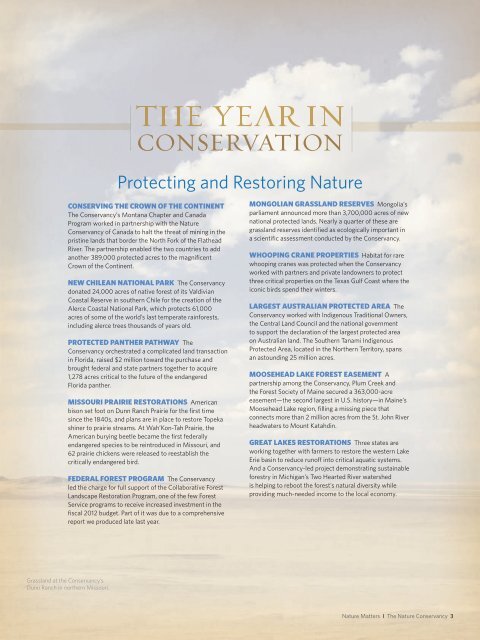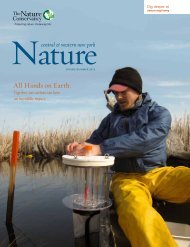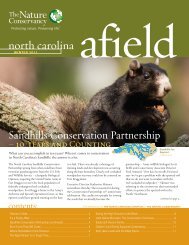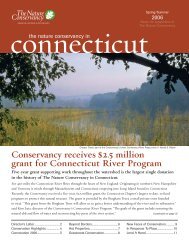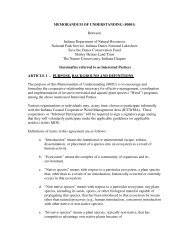2012 Annual Report - The Nature Conservancy
2012 Annual Report - The Nature Conservancy
2012 Annual Report - The Nature Conservancy
You also want an ePaper? Increase the reach of your titles
YUMPU automatically turns print PDFs into web optimized ePapers that Google loves.
THE YEAR IN<br />
CONSERVATION<br />
Protecting and Restoring <strong>Nature</strong><br />
CONSERVING THE CROWN OF THE CONTINENT<br />
<strong>The</strong> <strong>Conservancy</strong>’s Montana Chapter and Canada<br />
Program worked in partnership with the <strong>Nature</strong><br />
<strong>Conservancy</strong> of Canada to halt the threat of mining in the<br />
pristine lands that border the North Fork of the Flathead<br />
River. <strong>The</strong> partnership enabled the two countries to add<br />
another 389,000 protected acres to the magnificent<br />
Crown of the Continent.<br />
NEW CHILEAN NATIONAL PARK <strong>The</strong> <strong>Conservancy</strong><br />
donated 24,000 acres of native forest of its Valdivian<br />
Coastal Reserve in southern Chile for the creation of the<br />
Alerce Coastal National Park, which protects 61,000<br />
acres of some of the world’s last temperate rainforests,<br />
including alerce trees thousands of years old.<br />
PROTECTED PANTHER PATHWAY <strong>The</strong><br />
<strong>Conservancy</strong> orchestrated a complicated land transaction<br />
in Florida, raised $2 million toward the purchase and<br />
brought federal and state partners together to acquire<br />
1,278 acres critical to the future of the endangered<br />
Florida panther.<br />
MISSOURI PRAIRIE RESTORATIONS American<br />
bison set foot on Dunn Ranch Prairie for the first time<br />
since the 1840s, and plans are in place to restore Topeka<br />
shiner to prairie streams. At Wah’Kon-Tah Prairie, the<br />
American burying beetle became the first federally<br />
endangered species to be reintroduced in Missouri, and<br />
62 prairie chickens were released to reestablish the<br />
critically endangered bird.<br />
FEDERAL FOREST PROGRAM <strong>The</strong> <strong>Conservancy</strong><br />
led the charge for full support of the Collaborative Forest<br />
Landscape Restoration Program, one of the few Forest<br />
Service programs to receive increased investment in the<br />
fiscal <strong>2012</strong> budget. Part of it was due to a comprehensive<br />
report we produced late last year.<br />
MONGOLIAN GRASSLAND RESERVES Mongolia’s<br />
parliament announced more than 3,700,000 acres of new<br />
national protected lands. Nearly a quarter of these are<br />
grassland reserves identified as ecologically important in<br />
a scientific assessment conducted by the <strong>Conservancy</strong>.<br />
WHOOPING CRANE PROPERTIES Habitat for rare<br />
whooping cranes was protected when the <strong>Conservancy</strong><br />
worked with partners and private landowners to protect<br />
three critical properties on the Texas Gulf Coast where the<br />
iconic birds spend their winters.<br />
LARGEST AUSTRALIAN PROTECTED AREA <strong>The</strong><br />
<strong>Conservancy</strong> worked with Indigenous Traditional Owners,<br />
the Central Land Council and the national government<br />
to support the declaration of the largest protected area<br />
on Australian land. <strong>The</strong> Southern Tanami Indigenous<br />
Protected Area, located in the Northern Territory, spans<br />
an astounding 25 million acres.<br />
MOOSEHEAD LAKE FOREST EASEMENT A<br />
partnership among the <strong>Conservancy</strong>, Plum Creek and<br />
the Forest Society of Maine secured a 363,000-acre<br />
easement—the second largest in U.S. history—in Maine’s<br />
Moosehead Lake region, filling a missing piece that<br />
connects more than 2 million acres from the St. John River<br />
headwaters to Mount Katahdin.<br />
GREAT LAKES RESTORATIONS Three states are<br />
working together with farmers to restore the western Lake<br />
Erie basin to reduce runoff into critical aquatic systems.<br />
And a <strong>Conservancy</strong>-led project demonstrating sustainable<br />
forestry in Michigan’s Two Hearted River watershed<br />
is helping to reboot the forest’s natural diversity while<br />
providing much-needed income to the local economy.<br />
Grassland at the <strong>Conservancy</strong>’s<br />
Dunn Ranch in northern Missouri.<br />
<strong>Nature</strong> Matters I <strong>The</strong> <strong>Nature</strong> <strong>Conservancy</strong> 3


